Executive Summary: CPD and Organisational Competitiveness Project
VerifiedAdded on 2020/10/23
|47
|10481
|348
Project
AI Summary
This capstone project executive summary explores the significance of continuous professional learning and development (CPD) in fostering a productive and competitive business environment. The project investigates the impact of CPD programs on employee motivation, job satisfaction, productivity, and retention, ultimately aiming to determine their role in enhancing organizational competitiveness. The research includes a detailed literature review, outlining various types of CPD programs and their effects, as well as an analysis of the relationship between CPD and organizational outcomes. The project's objectives are to understand the concept of CPD, determine its role in enhancing organizational competitiveness, and evaluate the different types of CPD programs implemented in organizations. The research questions address whether CPD increases an organization's competitive advantage, and the project proposes a hypothesis to test this relationship. The project also covers the research methodology and provides recommendations based on the findings.
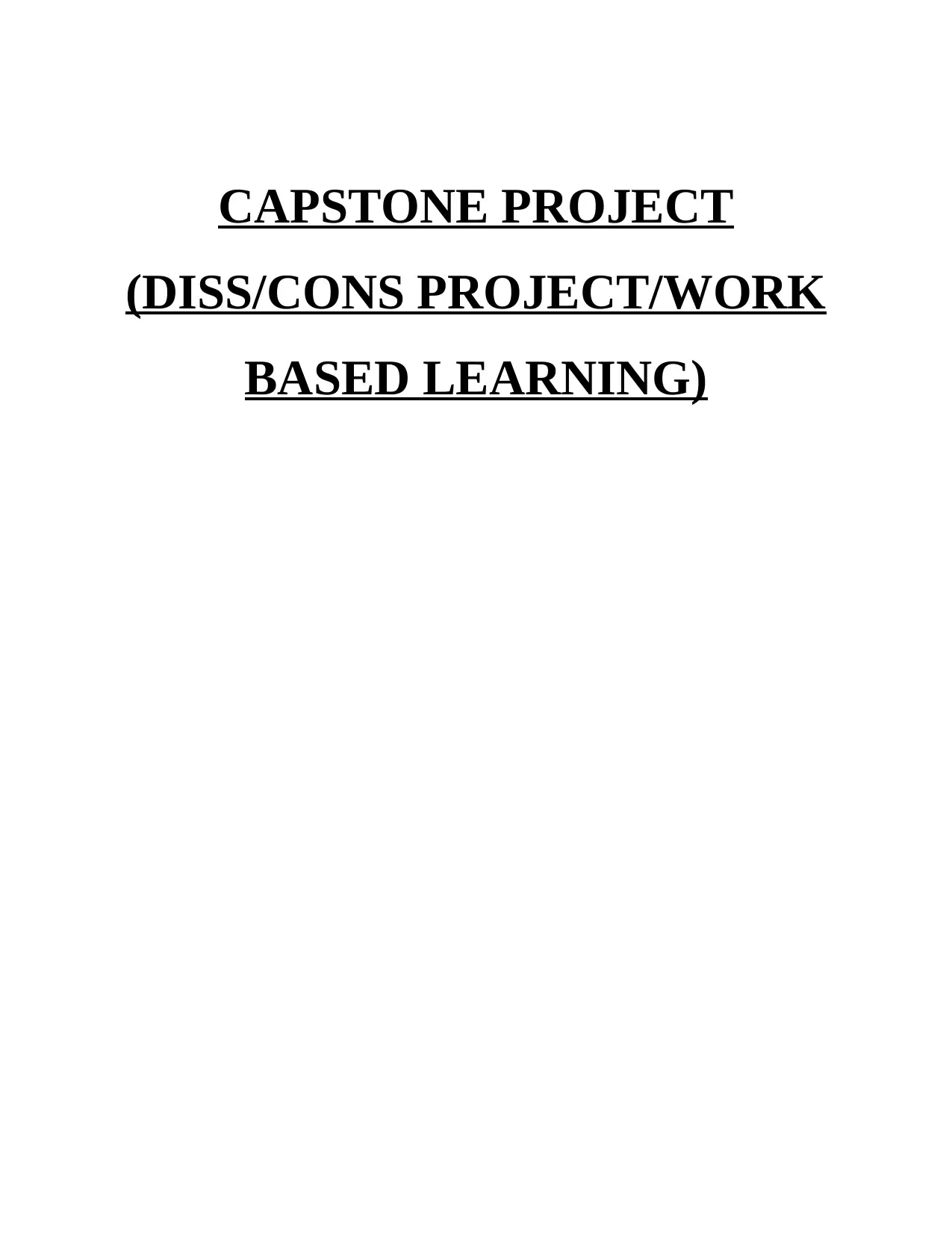
CAPSTONE PROJECT
(DISS/CONS PROJECT/WORK
BASED LEARNING)
(DISS/CONS PROJECT/WORK
BASED LEARNING)
Paraphrase This Document
Need a fresh take? Get an instant paraphrase of this document with our AI Paraphraser
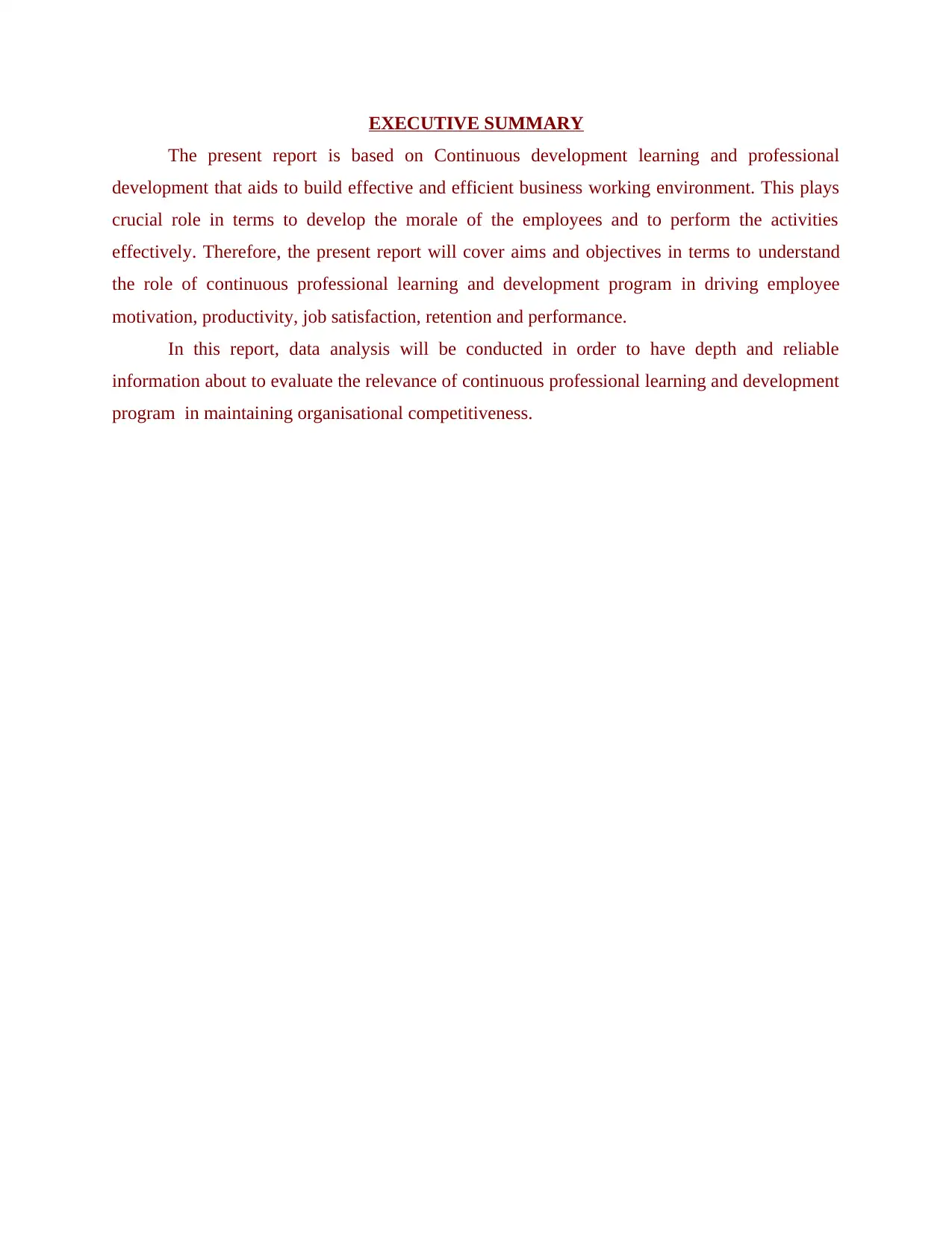
EXECUTIVE SUMMARY
The present report is based on Continuous development learning and professional
development that aids to build effective and efficient business working environment. This plays
crucial role in terms to develop the morale of the employees and to perform the activities
effectively. Therefore, the present report will cover aims and objectives in terms to understand
the role of continuous professional learning and development program in driving employee
motivation, productivity, job satisfaction, retention and performance.
In this report, data analysis will be conducted in order to have depth and reliable
information about to evaluate the relevance of continuous professional learning and development
program in maintaining organisational competitiveness.
The present report is based on Continuous development learning and professional
development that aids to build effective and efficient business working environment. This plays
crucial role in terms to develop the morale of the employees and to perform the activities
effectively. Therefore, the present report will cover aims and objectives in terms to understand
the role of continuous professional learning and development program in driving employee
motivation, productivity, job satisfaction, retention and performance.
In this report, data analysis will be conducted in order to have depth and reliable
information about to evaluate the relevance of continuous professional learning and development
program in maintaining organisational competitiveness.
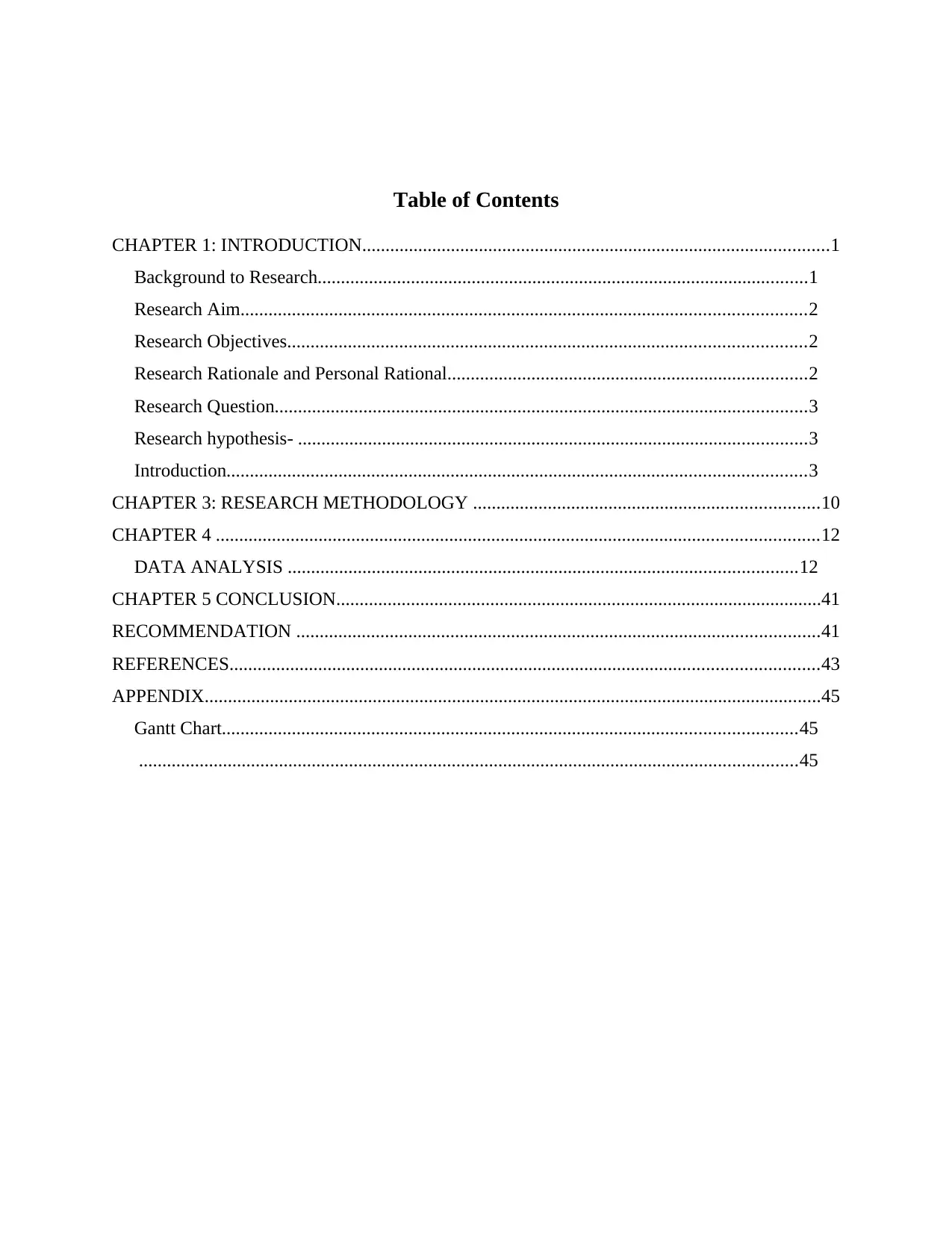
Table of Contents
CHAPTER 1: INTRODUCTION....................................................................................................1
Background to Research.........................................................................................................1
Research Aim.........................................................................................................................2
Research Objectives...............................................................................................................2
Research Rationale and Personal Rational.............................................................................2
Research Question..................................................................................................................3
Research hypothesis- .............................................................................................................3
Introduction............................................................................................................................3
CHAPTER 3: RESEARCH METHODOLOGY ..........................................................................10
CHAPTER 4 .................................................................................................................................12
DATA ANALYSIS .............................................................................................................12
CHAPTER 5 CONCLUSION........................................................................................................41
RECOMMENDATION ................................................................................................................41
REFERENCES..............................................................................................................................43
APPENDIX....................................................................................................................................45
Gantt Chart...........................................................................................................................45
.............................................................................................................................................45
CHAPTER 1: INTRODUCTION....................................................................................................1
Background to Research.........................................................................................................1
Research Aim.........................................................................................................................2
Research Objectives...............................................................................................................2
Research Rationale and Personal Rational.............................................................................2
Research Question..................................................................................................................3
Research hypothesis- .............................................................................................................3
Introduction............................................................................................................................3
CHAPTER 3: RESEARCH METHODOLOGY ..........................................................................10
CHAPTER 4 .................................................................................................................................12
DATA ANALYSIS .............................................................................................................12
CHAPTER 5 CONCLUSION........................................................................................................41
RECOMMENDATION ................................................................................................................41
REFERENCES..............................................................................................................................43
APPENDIX....................................................................................................................................45
Gantt Chart...........................................................................................................................45
.............................................................................................................................................45
⊘ This is a preview!⊘
Do you want full access?
Subscribe today to unlock all pages.

Trusted by 1+ million students worldwide
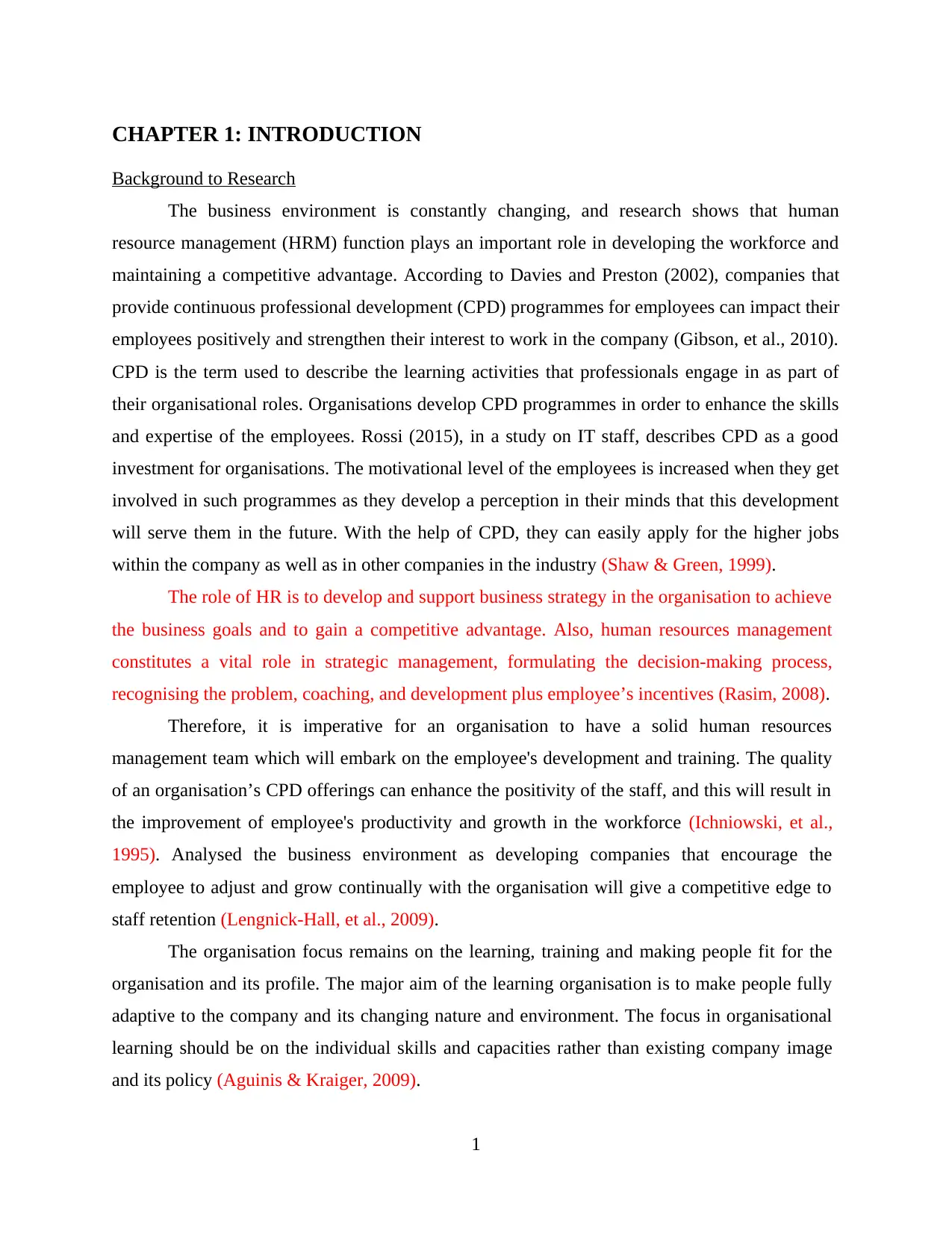
CHAPTER 1: INTRODUCTION
Background to Research
The business environment is constantly changing, and research shows that human
resource management (HRM) function plays an important role in developing the workforce and
maintaining a competitive advantage. According to Davies and Preston (2002), companies that
provide continuous professional development (CPD) programmes for employees can impact their
employees positively and strengthen their interest to work in the company (Gibson, et al., 2010).
CPD is the term used to describe the learning activities that professionals engage in as part of
their organisational roles. Organisations develop CPD programmes in order to enhance the skills
and expertise of the employees. Rossi (2015), in a study on IT staff, describes CPD as a good
investment for organisations. The motivational level of the employees is increased when they get
involved in such programmes as they develop a perception in their minds that this development
will serve them in the future. With the help of CPD, they can easily apply for the higher jobs
within the company as well as in other companies in the industry (Shaw & Green, 1999).
The role of HR is to develop and support business strategy in the organisation to achieve
the business goals and to gain a competitive advantage. Also, human resources management
constitutes a vital role in strategic management, formulating the decision-making process,
recognising the problem, coaching, and development plus employee’s incentives (Rasim, 2008).
Therefore, it is imperative for an organisation to have a solid human resources
management team which will embark on the employee's development and training. The quality
of an organisation’s CPD offerings can enhance the positivity of the staff, and this will result in
the improvement of employee's productivity and growth in the workforce (Ichniowski, et al.,
1995). Analysed the business environment as developing companies that encourage the
employee to adjust and grow continually with the organisation will give a competitive edge to
staff retention (Lengnick-Hall, et al., 2009).
The organisation focus remains on the learning, training and making people fit for the
organisation and its profile. The major aim of the learning organisation is to make people fully
adaptive to the company and its changing nature and environment. The focus in organisational
learning should be on the individual skills and capacities rather than existing company image
and its policy (Aguinis & Kraiger, 2009).
1
Background to Research
The business environment is constantly changing, and research shows that human
resource management (HRM) function plays an important role in developing the workforce and
maintaining a competitive advantage. According to Davies and Preston (2002), companies that
provide continuous professional development (CPD) programmes for employees can impact their
employees positively and strengthen their interest to work in the company (Gibson, et al., 2010).
CPD is the term used to describe the learning activities that professionals engage in as part of
their organisational roles. Organisations develop CPD programmes in order to enhance the skills
and expertise of the employees. Rossi (2015), in a study on IT staff, describes CPD as a good
investment for organisations. The motivational level of the employees is increased when they get
involved in such programmes as they develop a perception in their minds that this development
will serve them in the future. With the help of CPD, they can easily apply for the higher jobs
within the company as well as in other companies in the industry (Shaw & Green, 1999).
The role of HR is to develop and support business strategy in the organisation to achieve
the business goals and to gain a competitive advantage. Also, human resources management
constitutes a vital role in strategic management, formulating the decision-making process,
recognising the problem, coaching, and development plus employee’s incentives (Rasim, 2008).
Therefore, it is imperative for an organisation to have a solid human resources
management team which will embark on the employee's development and training. The quality
of an organisation’s CPD offerings can enhance the positivity of the staff, and this will result in
the improvement of employee's productivity and growth in the workforce (Ichniowski, et al.,
1995). Analysed the business environment as developing companies that encourage the
employee to adjust and grow continually with the organisation will give a competitive edge to
staff retention (Lengnick-Hall, et al., 2009).
The organisation focus remains on the learning, training and making people fit for the
organisation and its profile. The major aim of the learning organisation is to make people fully
adaptive to the company and its changing nature and environment. The focus in organisational
learning should be on the individual skills and capacities rather than existing company image
and its policy (Aguinis & Kraiger, 2009).
1
Paraphrase This Document
Need a fresh take? Get an instant paraphrase of this document with our AI Paraphraser
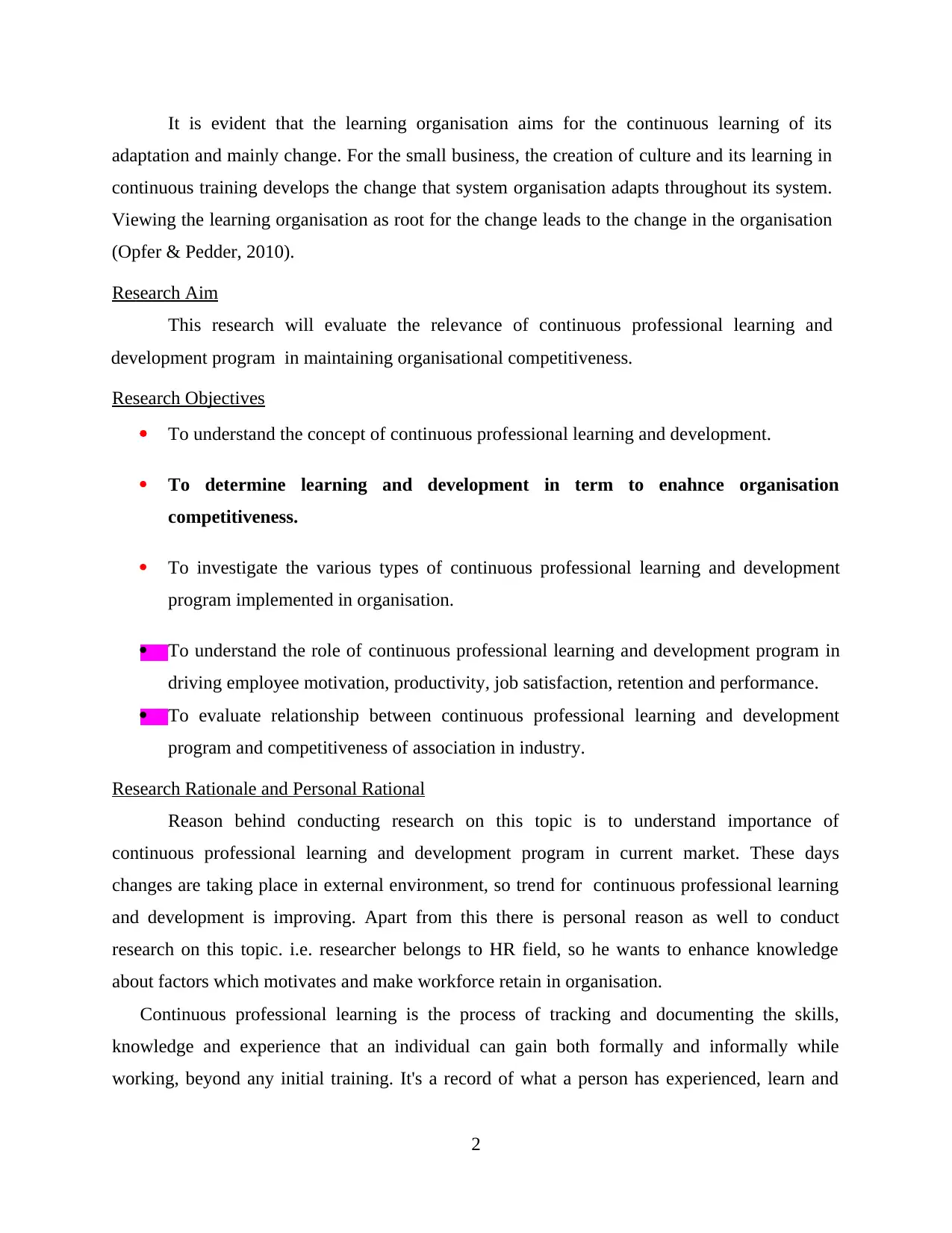
It is evident that the learning organisation aims for the continuous learning of its
adaptation and mainly change. For the small business, the creation of culture and its learning in
continuous training develops the change that system organisation adapts throughout its system.
Viewing the learning organisation as root for the change leads to the change in the organisation
(Opfer & Pedder, 2010).
Research Aim
This research will evaluate the relevance of continuous professional learning and
development program in maintaining organisational competitiveness.
Research Objectives
To understand the concept of continuous professional learning and development.
To determine learning and development in term to enahnce organisation
competitiveness.
To investigate the various types of continuous professional learning and development
program implemented in organisation.
To understand the role of continuous professional learning and development program in
driving employee motivation, productivity, job satisfaction, retention and performance.
To evaluate relationship between continuous professional learning and development
program and competitiveness of association in industry.
Research Rationale and Personal Rational
Reason behind conducting research on this topic is to understand importance of
continuous professional learning and development program in current market. These days
changes are taking place in external environment, so trend for continuous professional learning
and development is improving. Apart from this there is personal reason as well to conduct
research on this topic. i.e. researcher belongs to HR field, so he wants to enhance knowledge
about factors which motivates and make workforce retain in organisation.
Continuous professional learning is the process of tracking and documenting the skills,
knowledge and experience that an individual can gain both formally and informally while
working, beyond any initial training. It's a record of what a person has experienced, learn and
2
adaptation and mainly change. For the small business, the creation of culture and its learning in
continuous training develops the change that system organisation adapts throughout its system.
Viewing the learning organisation as root for the change leads to the change in the organisation
(Opfer & Pedder, 2010).
Research Aim
This research will evaluate the relevance of continuous professional learning and
development program in maintaining organisational competitiveness.
Research Objectives
To understand the concept of continuous professional learning and development.
To determine learning and development in term to enahnce organisation
competitiveness.
To investigate the various types of continuous professional learning and development
program implemented in organisation.
To understand the role of continuous professional learning and development program in
driving employee motivation, productivity, job satisfaction, retention and performance.
To evaluate relationship between continuous professional learning and development
program and competitiveness of association in industry.
Research Rationale and Personal Rational
Reason behind conducting research on this topic is to understand importance of
continuous professional learning and development program in current market. These days
changes are taking place in external environment, so trend for continuous professional learning
and development is improving. Apart from this there is personal reason as well to conduct
research on this topic. i.e. researcher belongs to HR field, so he wants to enhance knowledge
about factors which motivates and make workforce retain in organisation.
Continuous professional learning is the process of tracking and documenting the skills,
knowledge and experience that an individual can gain both formally and informally while
working, beyond any initial training. It's a record of what a person has experienced, learn and
2
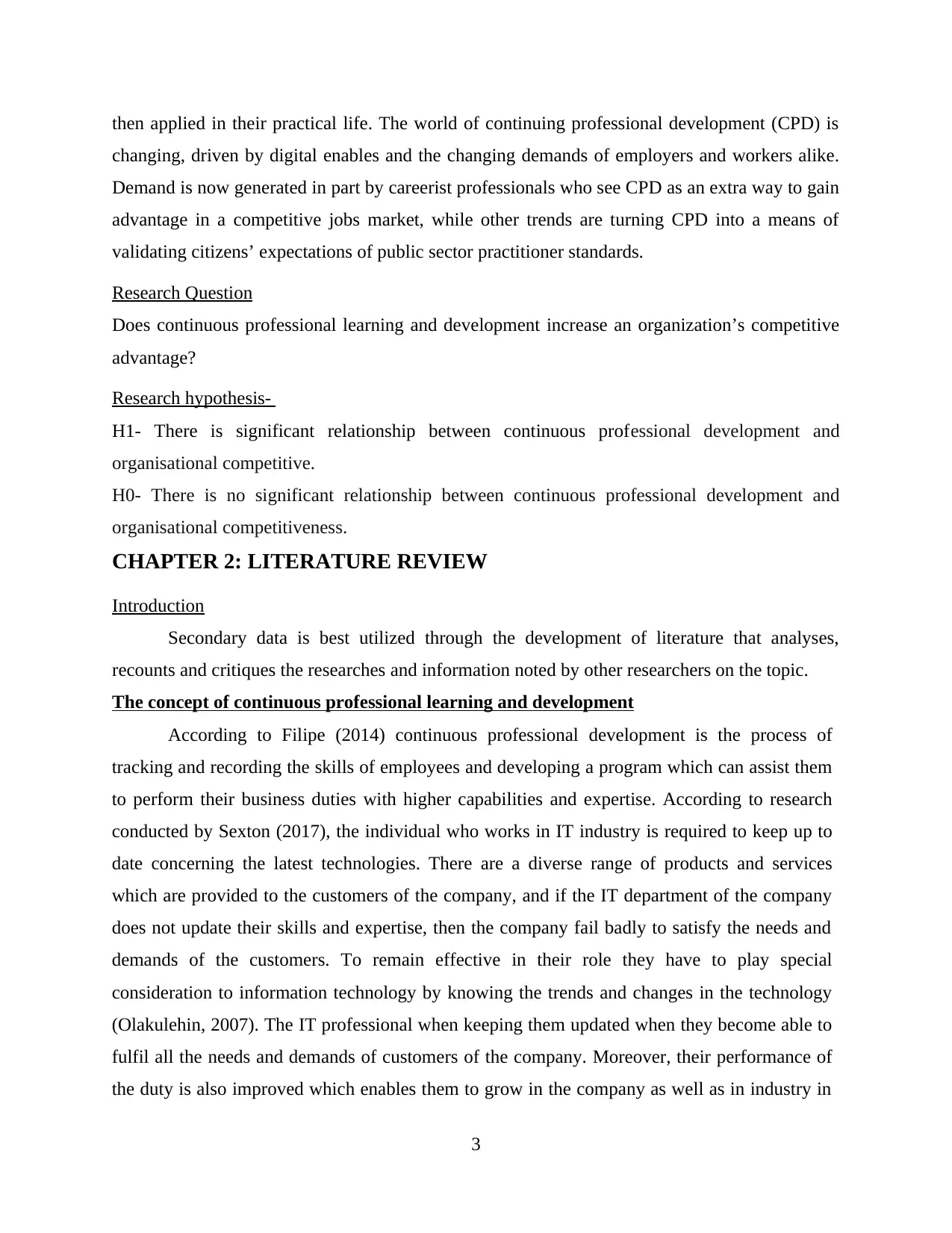
then applied in their practical life. The world of continuing professional development (CPD) is
changing, driven by digital enables and the changing demands of employers and workers alike.
Demand is now generated in part by careerist professionals who see CPD as an extra way to gain
advantage in a competitive jobs market, while other trends are turning CPD into a means of
validating citizens’ expectations of public sector practitioner standards.
Research Question
Does continuous professional learning and development increase an organization’s competitive
advantage?
Research hypothesis-
H1- There is significant relationship between continuous professional development and
organisational competitive.
H0- There is no significant relationship between continuous professional development and
organisational competitiveness.
CHAPTER 2: LITERATURE REVIEW
Introduction
Secondary data is best utilized through the development of literature that analyses,
recounts and critiques the researches and information noted by other researchers on the topic.
The concept of continuous professional learning and development
According to Filipe (2014) continuous professional development is the process of
tracking and recording the skills of employees and developing a program which can assist them
to perform their business duties with higher capabilities and expertise. According to research
conducted by Sexton (2017), the individual who works in IT industry is required to keep up to
date concerning the latest technologies. There are a diverse range of products and services
which are provided to the customers of the company, and if the IT department of the company
does not update their skills and expertise, then the company fail badly to satisfy the needs and
demands of the customers. To remain effective in their role they have to play special
consideration to information technology by knowing the trends and changes in the technology
(Olakulehin, 2007). The IT professional when keeping them updated when they become able to
fulfil all the needs and demands of customers of the company. Moreover, their performance of
the duty is also improved which enables them to grow in the company as well as in industry in
3
changing, driven by digital enables and the changing demands of employers and workers alike.
Demand is now generated in part by careerist professionals who see CPD as an extra way to gain
advantage in a competitive jobs market, while other trends are turning CPD into a means of
validating citizens’ expectations of public sector practitioner standards.
Research Question
Does continuous professional learning and development increase an organization’s competitive
advantage?
Research hypothesis-
H1- There is significant relationship between continuous professional development and
organisational competitive.
H0- There is no significant relationship between continuous professional development and
organisational competitiveness.
CHAPTER 2: LITERATURE REVIEW
Introduction
Secondary data is best utilized through the development of literature that analyses,
recounts and critiques the researches and information noted by other researchers on the topic.
The concept of continuous professional learning and development
According to Filipe (2014) continuous professional development is the process of
tracking and recording the skills of employees and developing a program which can assist them
to perform their business duties with higher capabilities and expertise. According to research
conducted by Sexton (2017), the individual who works in IT industry is required to keep up to
date concerning the latest technologies. There are a diverse range of products and services
which are provided to the customers of the company, and if the IT department of the company
does not update their skills and expertise, then the company fail badly to satisfy the needs and
demands of the customers. To remain effective in their role they have to play special
consideration to information technology by knowing the trends and changes in the technology
(Olakulehin, 2007). The IT professional when keeping them updated when they become able to
fulfil all the needs and demands of customers of the company. Moreover, their performance of
the duty is also improved which enables them to grow in the company as well as in industry in
3
⊘ This is a preview!⊘
Do you want full access?
Subscribe today to unlock all pages.

Trusted by 1+ million students worldwide
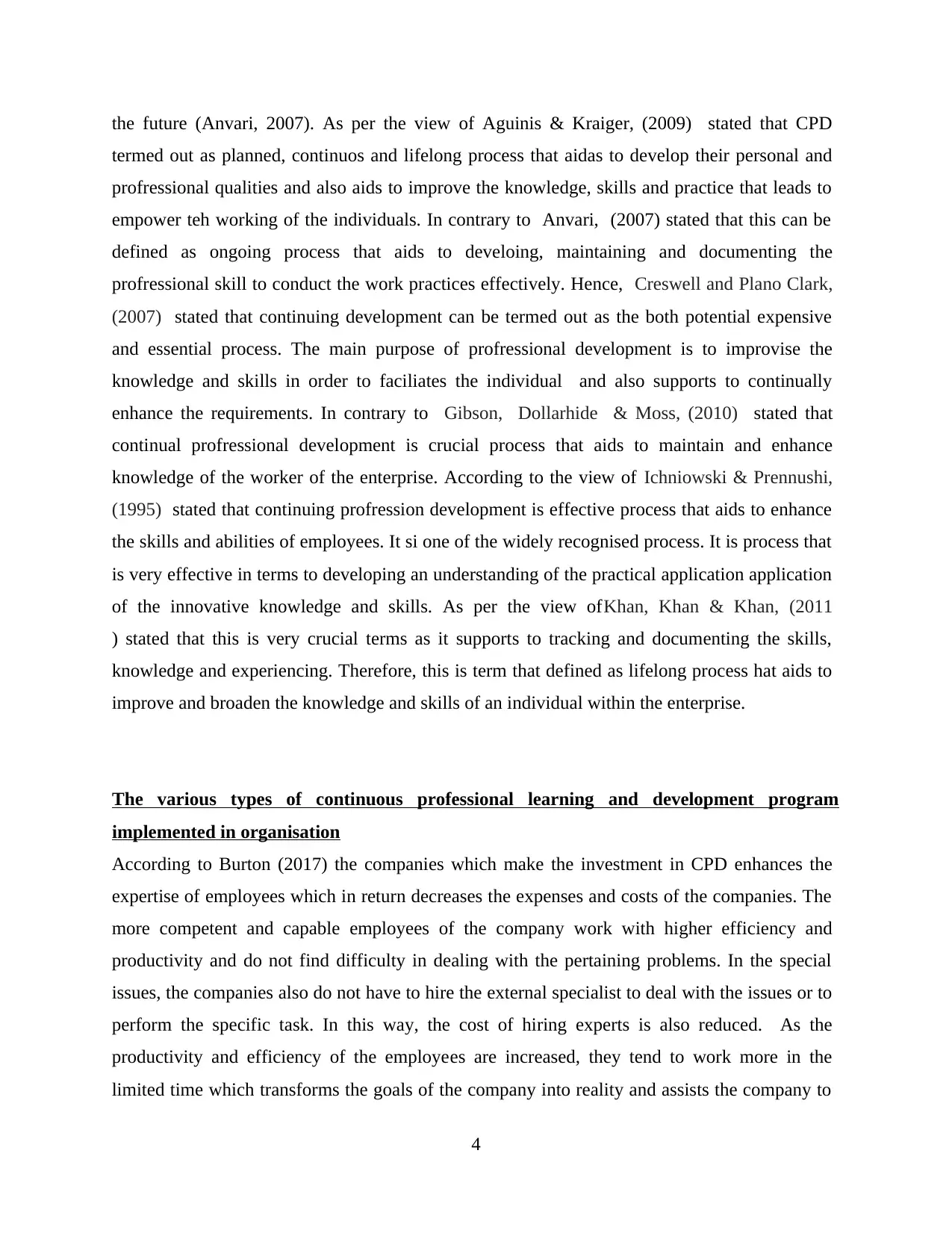
the future (Anvari, 2007). As per the view of Aguinis & Kraiger, (2009) stated that CPD
termed out as planned, continuos and lifelong process that aidas to develop their personal and
profressional qualities and also aids to improve the knowledge, skills and practice that leads to
empower teh working of the individuals. In contrary to Anvari, (2007) stated that this can be
defined as ongoing process that aids to develoing, maintaining and documenting the
profressional skill to conduct the work practices effectively. Hence, Creswell and Plano Clark,
(2007) stated that continuing development can be termed out as the both potential expensive
and essential process. The main purpose of profressional development is to improvise the
knowledge and skills in order to faciliates the individual and also supports to continually
enhance the requirements. In contrary to Gibson, Dollarhide & Moss, (2010) stated that
continual profressional development is crucial process that aids to maintain and enhance
knowledge of the worker of the enterprise. According to the view of Ichniowski & Prennushi,
(1995) stated that continuing profression development is effective process that aids to enhance
the skills and abilities of employees. It si one of the widely recognised process. It is process that
is very effective in terms to developing an understanding of the practical application application
of the innovative knowledge and skills. As per the view ofKhan, Khan & Khan, (2011
) stated that this is very crucial terms as it supports to tracking and documenting the skills,
knowledge and experiencing. Therefore, this is term that defined as lifelong process hat aids to
improve and broaden the knowledge and skills of an individual within the enterprise.
The various types of continuous professional learning and development program
implemented in organisation
According to Burton (2017) the companies which make the investment in CPD enhances the
expertise of employees which in return decreases the expenses and costs of the companies. The
more competent and capable employees of the company work with higher efficiency and
productivity and do not find difficulty in dealing with the pertaining problems. In the special
issues, the companies also do not have to hire the external specialist to deal with the issues or to
perform the specific task. In this way, the cost of hiring experts is also reduced. As the
productivity and efficiency of the employees are increased, they tend to work more in the
limited time which transforms the goals of the company into reality and assists the company to
4
termed out as planned, continuos and lifelong process that aidas to develop their personal and
profressional qualities and also aids to improve the knowledge, skills and practice that leads to
empower teh working of the individuals. In contrary to Anvari, (2007) stated that this can be
defined as ongoing process that aids to develoing, maintaining and documenting the
profressional skill to conduct the work practices effectively. Hence, Creswell and Plano Clark,
(2007) stated that continuing development can be termed out as the both potential expensive
and essential process. The main purpose of profressional development is to improvise the
knowledge and skills in order to faciliates the individual and also supports to continually
enhance the requirements. In contrary to Gibson, Dollarhide & Moss, (2010) stated that
continual profressional development is crucial process that aids to maintain and enhance
knowledge of the worker of the enterprise. According to the view of Ichniowski & Prennushi,
(1995) stated that continuing profression development is effective process that aids to enhance
the skills and abilities of employees. It si one of the widely recognised process. It is process that
is very effective in terms to developing an understanding of the practical application application
of the innovative knowledge and skills. As per the view ofKhan, Khan & Khan, (2011
) stated that this is very crucial terms as it supports to tracking and documenting the skills,
knowledge and experiencing. Therefore, this is term that defined as lifelong process hat aids to
improve and broaden the knowledge and skills of an individual within the enterprise.
The various types of continuous professional learning and development program
implemented in organisation
According to Burton (2017) the companies which make the investment in CPD enhances the
expertise of employees which in return decreases the expenses and costs of the companies. The
more competent and capable employees of the company work with higher efficiency and
productivity and do not find difficulty in dealing with the pertaining problems. In the special
issues, the companies also do not have to hire the external specialist to deal with the issues or to
perform the specific task. In this way, the cost of hiring experts is also reduced. As the
productivity and efficiency of the employees are increased, they tend to work more in the
limited time which transforms the goals of the company into reality and assists the company to
4
Paraphrase This Document
Need a fresh take? Get an instant paraphrase of this document with our AI Paraphraser
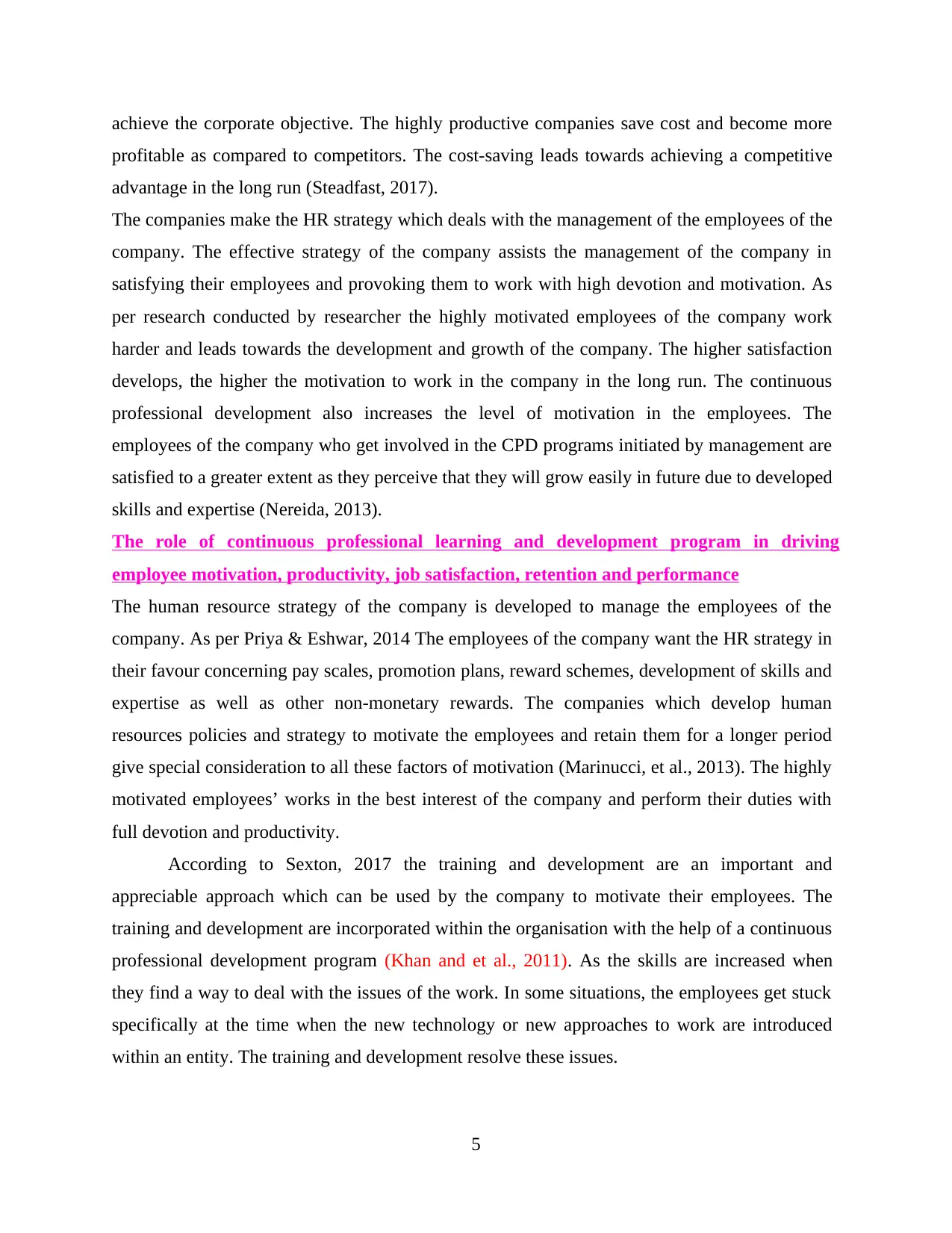
achieve the corporate objective. The highly productive companies save cost and become more
profitable as compared to competitors. The cost-saving leads towards achieving a competitive
advantage in the long run (Steadfast, 2017).
The companies make the HR strategy which deals with the management of the employees of the
company. The effective strategy of the company assists the management of the company in
satisfying their employees and provoking them to work with high devotion and motivation. As
per research conducted by researcher the highly motivated employees of the company work
harder and leads towards the development and growth of the company. The higher satisfaction
develops, the higher the motivation to work in the company in the long run. The continuous
professional development also increases the level of motivation in the employees. The
employees of the company who get involved in the CPD programs initiated by management are
satisfied to a greater extent as they perceive that they will grow easily in future due to developed
skills and expertise (Nereida, 2013).
The role of continuous professional learning and development program in driving
employee motivation, productivity, job satisfaction, retention and performance
The human resource strategy of the company is developed to manage the employees of the
company. As per Priya & Eshwar, 2014 The employees of the company want the HR strategy in
their favour concerning pay scales, promotion plans, reward schemes, development of skills and
expertise as well as other non-monetary rewards. The companies which develop human
resources policies and strategy to motivate the employees and retain them for a longer period
give special consideration to all these factors of motivation (Marinucci, et al., 2013). The highly
motivated employees’ works in the best interest of the company and perform their duties with
full devotion and productivity.
According to Sexton, 2017 the training and development are an important and
appreciable approach which can be used by the company to motivate their employees. The
training and development are incorporated within the organisation with the help of a continuous
professional development program (Khan and et al., 2011). As the skills are increased when
they find a way to deal with the issues of the work. In some situations, the employees get stuck
specifically at the time when the new technology or new approaches to work are introduced
within an entity. The training and development resolve these issues.
5
profitable as compared to competitors. The cost-saving leads towards achieving a competitive
advantage in the long run (Steadfast, 2017).
The companies make the HR strategy which deals with the management of the employees of the
company. The effective strategy of the company assists the management of the company in
satisfying their employees and provoking them to work with high devotion and motivation. As
per research conducted by researcher the highly motivated employees of the company work
harder and leads towards the development and growth of the company. The higher satisfaction
develops, the higher the motivation to work in the company in the long run. The continuous
professional development also increases the level of motivation in the employees. The
employees of the company who get involved in the CPD programs initiated by management are
satisfied to a greater extent as they perceive that they will grow easily in future due to developed
skills and expertise (Nereida, 2013).
The role of continuous professional learning and development program in driving
employee motivation, productivity, job satisfaction, retention and performance
The human resource strategy of the company is developed to manage the employees of the
company. As per Priya & Eshwar, 2014 The employees of the company want the HR strategy in
their favour concerning pay scales, promotion plans, reward schemes, development of skills and
expertise as well as other non-monetary rewards. The companies which develop human
resources policies and strategy to motivate the employees and retain them for a longer period
give special consideration to all these factors of motivation (Marinucci, et al., 2013). The highly
motivated employees’ works in the best interest of the company and perform their duties with
full devotion and productivity.
According to Sexton, 2017 the training and development are an important and
appreciable approach which can be used by the company to motivate their employees. The
training and development are incorporated within the organisation with the help of a continuous
professional development program (Khan and et al., 2011). As the skills are increased when
they find a way to deal with the issues of the work. In some situations, the employees get stuck
specifically at the time when the new technology or new approaches to work are introduced
within an entity. The training and development resolve these issues.
5
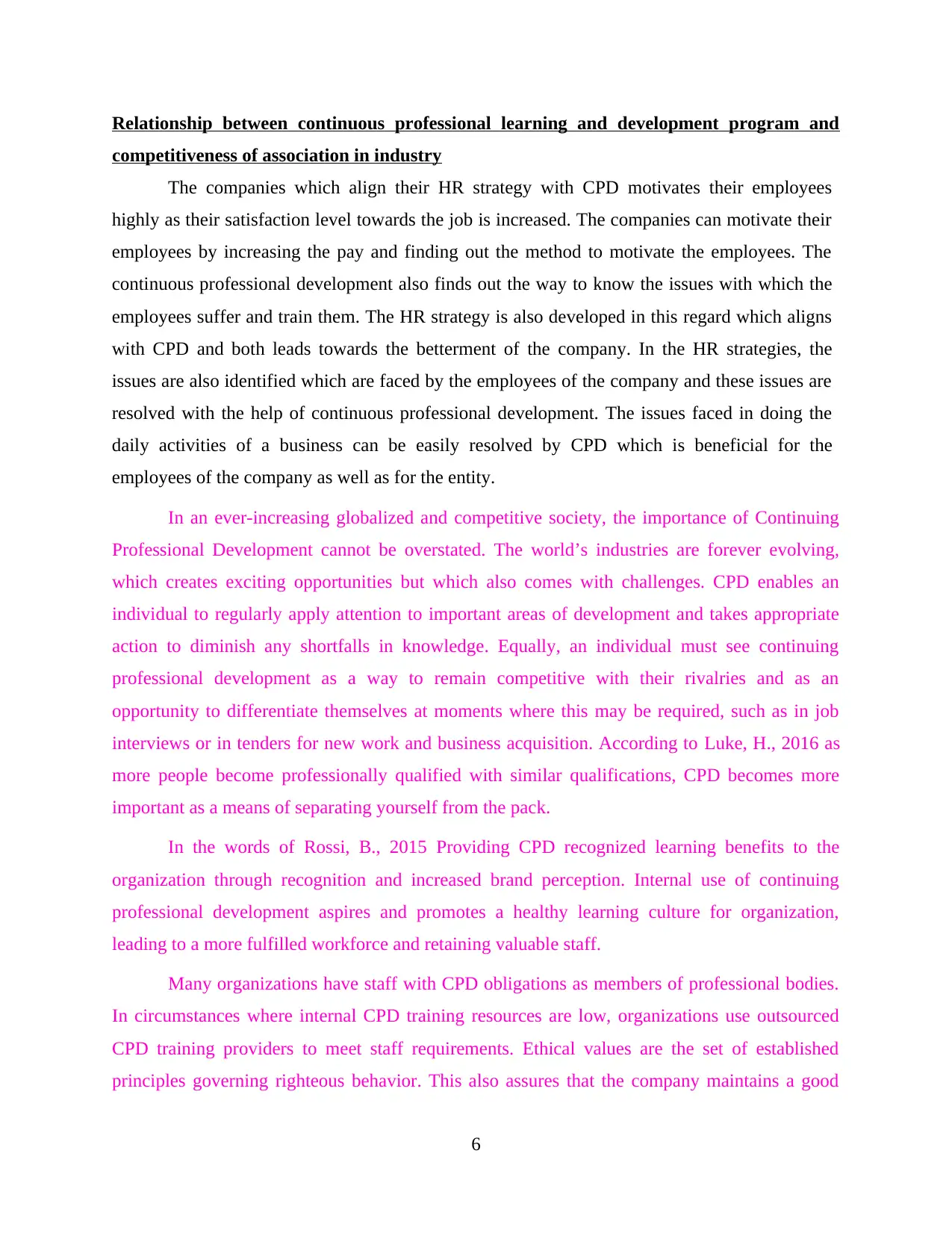
Relationship between continuous professional learning and development program and
competitiveness of association in industry
The companies which align their HR strategy with CPD motivates their employees
highly as their satisfaction level towards the job is increased. The companies can motivate their
employees by increasing the pay and finding out the method to motivate the employees. The
continuous professional development also finds out the way to know the issues with which the
employees suffer and train them. The HR strategy is also developed in this regard which aligns
with CPD and both leads towards the betterment of the company. In the HR strategies, the
issues are also identified which are faced by the employees of the company and these issues are
resolved with the help of continuous professional development. The issues faced in doing the
daily activities of a business can be easily resolved by CPD which is beneficial for the
employees of the company as well as for the entity.
In an ever-increasing globalized and competitive society, the importance of Continuing
Professional Development cannot be overstated. The world’s industries are forever evolving,
which creates exciting opportunities but which also comes with challenges. CPD enables an
individual to regularly apply attention to important areas of development and takes appropriate
action to diminish any shortfalls in knowledge. Equally, an individual must see continuing
professional development as a way to remain competitive with their rivalries and as an
opportunity to differentiate themselves at moments where this may be required, such as in job
interviews or in tenders for new work and business acquisition. According to Luke, H., 2016 as
more people become professionally qualified with similar qualifications, CPD becomes more
important as a means of separating yourself from the pack.
In the words of Rossi, B., 2015 Providing CPD recognized learning benefits to the
organization through recognition and increased brand perception. Internal use of continuing
professional development aspires and promotes a healthy learning culture for organization,
leading to a more fulfilled workforce and retaining valuable staff.
Many organizations have staff with CPD obligations as members of professional bodies.
In circumstances where internal CPD training resources are low, organizations use outsourced
CPD training providers to meet staff requirements. Ethical values are the set of established
principles governing righteous behavior. This also assures that the company maintains a good
6
competitiveness of association in industry
The companies which align their HR strategy with CPD motivates their employees
highly as their satisfaction level towards the job is increased. The companies can motivate their
employees by increasing the pay and finding out the method to motivate the employees. The
continuous professional development also finds out the way to know the issues with which the
employees suffer and train them. The HR strategy is also developed in this regard which aligns
with CPD and both leads towards the betterment of the company. In the HR strategies, the
issues are also identified which are faced by the employees of the company and these issues are
resolved with the help of continuous professional development. The issues faced in doing the
daily activities of a business can be easily resolved by CPD which is beneficial for the
employees of the company as well as for the entity.
In an ever-increasing globalized and competitive society, the importance of Continuing
Professional Development cannot be overstated. The world’s industries are forever evolving,
which creates exciting opportunities but which also comes with challenges. CPD enables an
individual to regularly apply attention to important areas of development and takes appropriate
action to diminish any shortfalls in knowledge. Equally, an individual must see continuing
professional development as a way to remain competitive with their rivalries and as an
opportunity to differentiate themselves at moments where this may be required, such as in job
interviews or in tenders for new work and business acquisition. According to Luke, H., 2016 as
more people become professionally qualified with similar qualifications, CPD becomes more
important as a means of separating yourself from the pack.
In the words of Rossi, B., 2015 Providing CPD recognized learning benefits to the
organization through recognition and increased brand perception. Internal use of continuing
professional development aspires and promotes a healthy learning culture for organization,
leading to a more fulfilled workforce and retaining valuable staff.
Many organizations have staff with CPD obligations as members of professional bodies.
In circumstances where internal CPD training resources are low, organizations use outsourced
CPD training providers to meet staff requirements. Ethical values are the set of established
principles governing righteous behavior. This also assures that the company maintains a good
6
⊘ This is a preview!⊘
Do you want full access?
Subscribe today to unlock all pages.

Trusted by 1+ million students worldwide
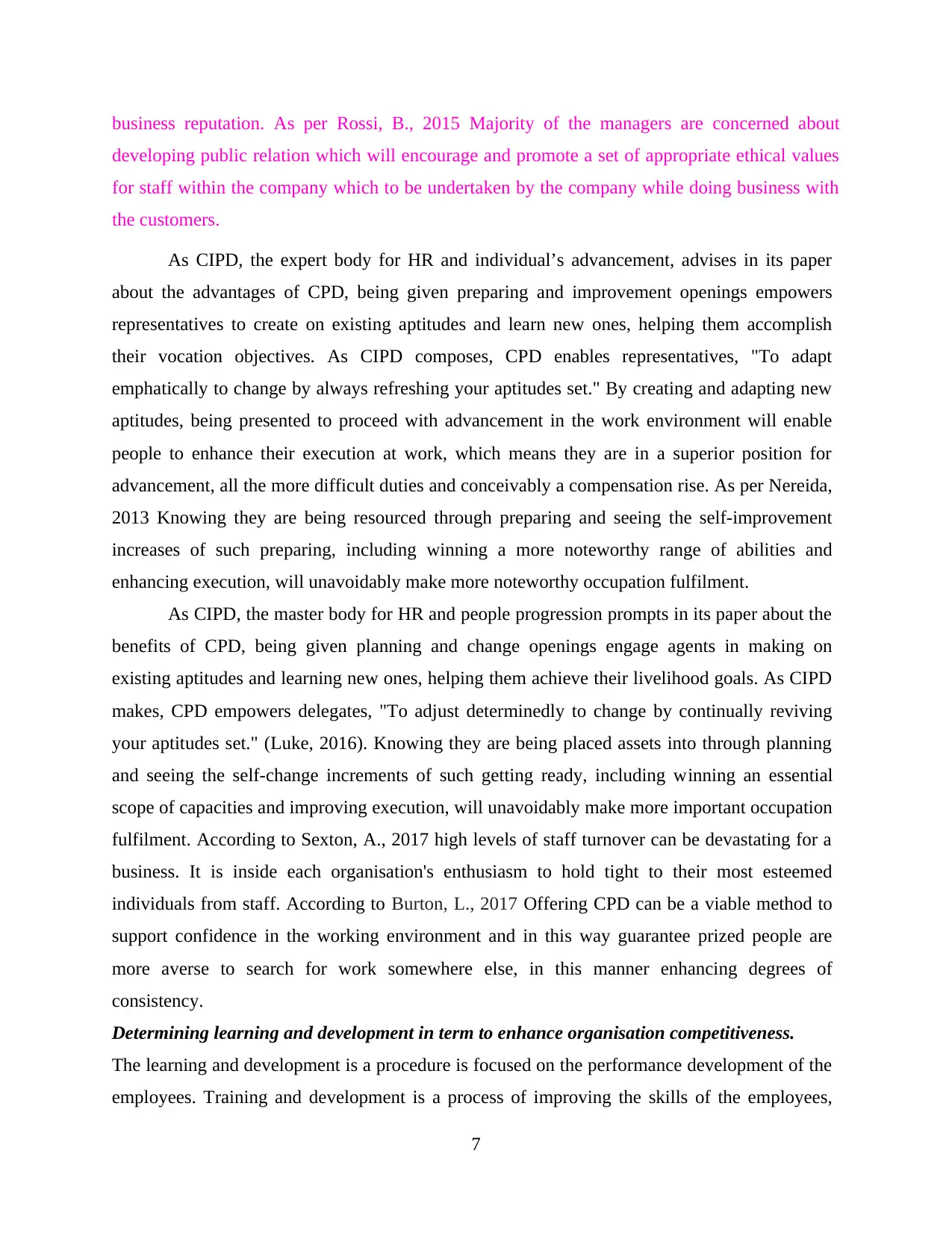
business reputation. As per Rossi, B., 2015 Majority of the managers are concerned about
developing public relation which will encourage and promote a set of appropriate ethical values
for staff within the company which to be undertaken by the company while doing business with
the customers.
As CIPD, the expert body for HR and individual’s advancement, advises in its paper
about the advantages of CPD, being given preparing and improvement openings empowers
representatives to create on existing aptitudes and learn new ones, helping them accomplish
their vocation objectives. As CIPD composes, CPD enables representatives, "To adapt
emphatically to change by always refreshing your aptitudes set." By creating and adapting new
aptitudes, being presented to proceed with advancement in the work environment will enable
people to enhance their execution at work, which means they are in a superior position for
advancement, all the more difficult duties and conceivably a compensation rise. As per Nereida,
2013 Knowing they are being resourced through preparing and seeing the self-improvement
increases of such preparing, including winning a more noteworthy range of abilities and
enhancing execution, will unavoidably make more noteworthy occupation fulfilment.
As CIPD, the master body for HR and people progression prompts in its paper about the
benefits of CPD, being given planning and change openings engage agents in making on
existing aptitudes and learning new ones, helping them achieve their livelihood goals. As CIPD
makes, CPD empowers delegates, "To adjust determinedly to change by continually reviving
your aptitudes set." (Luke, 2016). Knowing they are being placed assets into through planning
and seeing the self-change increments of such getting ready, including winning an essential
scope of capacities and improving execution, will unavoidably make more important occupation
fulfilment. According to Sexton, A., 2017 high levels of staff turnover can be devastating for a
business. It is inside each organisation's enthusiasm to hold tight to their most esteemed
individuals from staff. According to Burton, L., 2017 Offering CPD can be a viable method to
support confidence in the working environment and in this way guarantee prized people are
more averse to search for work somewhere else, in this manner enhancing degrees of
consistency.
Determining learning and development in term to enhance organisation competitiveness.
The learning and development is a procedure is focused on the performance development of the
employees. Training and development is a process of improving the skills of the employees,
7
developing public relation which will encourage and promote a set of appropriate ethical values
for staff within the company which to be undertaken by the company while doing business with
the customers.
As CIPD, the expert body for HR and individual’s advancement, advises in its paper
about the advantages of CPD, being given preparing and improvement openings empowers
representatives to create on existing aptitudes and learn new ones, helping them accomplish
their vocation objectives. As CIPD composes, CPD enables representatives, "To adapt
emphatically to change by always refreshing your aptitudes set." By creating and adapting new
aptitudes, being presented to proceed with advancement in the work environment will enable
people to enhance their execution at work, which means they are in a superior position for
advancement, all the more difficult duties and conceivably a compensation rise. As per Nereida,
2013 Knowing they are being resourced through preparing and seeing the self-improvement
increases of such preparing, including winning a more noteworthy range of abilities and
enhancing execution, will unavoidably make more noteworthy occupation fulfilment.
As CIPD, the master body for HR and people progression prompts in its paper about the
benefits of CPD, being given planning and change openings engage agents in making on
existing aptitudes and learning new ones, helping them achieve their livelihood goals. As CIPD
makes, CPD empowers delegates, "To adjust determinedly to change by continually reviving
your aptitudes set." (Luke, 2016). Knowing they are being placed assets into through planning
and seeing the self-change increments of such getting ready, including winning an essential
scope of capacities and improving execution, will unavoidably make more important occupation
fulfilment. According to Sexton, A., 2017 high levels of staff turnover can be devastating for a
business. It is inside each organisation's enthusiasm to hold tight to their most esteemed
individuals from staff. According to Burton, L., 2017 Offering CPD can be a viable method to
support confidence in the working environment and in this way guarantee prized people are
more averse to search for work somewhere else, in this manner enhancing degrees of
consistency.
Determining learning and development in term to enhance organisation competitiveness.
The learning and development is a procedure is focused on the performance development of the
employees. Training and development is a process of improving the skills of the employees,
7
Paraphrase This Document
Need a fresh take? Get an instant paraphrase of this document with our AI Paraphraser
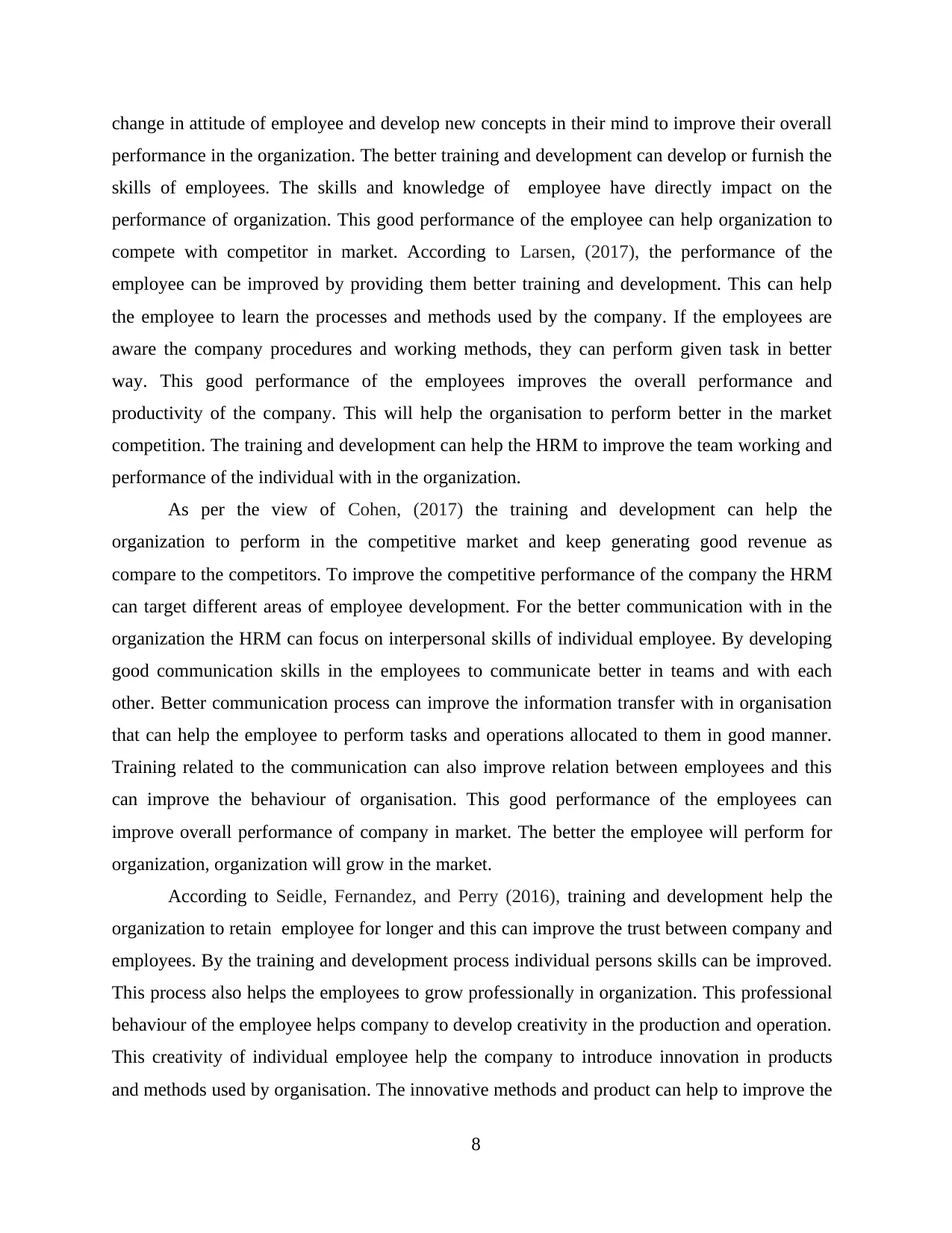
change in attitude of employee and develop new concepts in their mind to improve their overall
performance in the organization. The better training and development can develop or furnish the
skills of employees. The skills and knowledge of employee have directly impact on the
performance of organization. This good performance of the employee can help organization to
compete with competitor in market. According to Larsen, (2017), the performance of the
employee can be improved by providing them better training and development. This can help
the employee to learn the processes and methods used by the company. If the employees are
aware the company procedures and working methods, they can perform given task in better
way. This good performance of the employees improves the overall performance and
productivity of the company. This will help the organisation to perform better in the market
competition. The training and development can help the HRM to improve the team working and
performance of the individual with in the organization.
As per the view of Cohen, (2017) the training and development can help the
organization to perform in the competitive market and keep generating good revenue as
compare to the competitors. To improve the competitive performance of the company the HRM
can target different areas of employee development. For the better communication with in the
organization the HRM can focus on interpersonal skills of individual employee. By developing
good communication skills in the employees to communicate better in teams and with each
other. Better communication process can improve the information transfer with in organisation
that can help the employee to perform tasks and operations allocated to them in good manner.
Training related to the communication can also improve relation between employees and this
can improve the behaviour of organisation. This good performance of the employees can
improve overall performance of company in market. The better the employee will perform for
organization, organization will grow in the market.
According to Seidle, Fernandez, and Perry (2016), training and development help the
organization to retain employee for longer and this can improve the trust between company and
employees. By the training and development process individual persons skills can be improved.
This process also helps the employees to grow professionally in organization. This professional
behaviour of the employee helps company to develop creativity in the production and operation.
This creativity of individual employee help the company to introduce innovation in products
and methods used by organisation. The innovative methods and product can help to improve the
8
performance in the organization. The better training and development can develop or furnish the
skills of employees. The skills and knowledge of employee have directly impact on the
performance of organization. This good performance of the employee can help organization to
compete with competitor in market. According to Larsen, (2017), the performance of the
employee can be improved by providing them better training and development. This can help
the employee to learn the processes and methods used by the company. If the employees are
aware the company procedures and working methods, they can perform given task in better
way. This good performance of the employees improves the overall performance and
productivity of the company. This will help the organisation to perform better in the market
competition. The training and development can help the HRM to improve the team working and
performance of the individual with in the organization.
As per the view of Cohen, (2017) the training and development can help the
organization to perform in the competitive market and keep generating good revenue as
compare to the competitors. To improve the competitive performance of the company the HRM
can target different areas of employee development. For the better communication with in the
organization the HRM can focus on interpersonal skills of individual employee. By developing
good communication skills in the employees to communicate better in teams and with each
other. Better communication process can improve the information transfer with in organisation
that can help the employee to perform tasks and operations allocated to them in good manner.
Training related to the communication can also improve relation between employees and this
can improve the behaviour of organisation. This good performance of the employees can
improve overall performance of company in market. The better the employee will perform for
organization, organization will grow in the market.
According to Seidle, Fernandez, and Perry (2016), training and development help the
organization to retain employee for longer and this can improve the trust between company and
employees. By the training and development process individual persons skills can be improved.
This process also helps the employees to grow professionally in organization. This professional
behaviour of the employee helps company to develop creativity in the production and operation.
This creativity of individual employee help the company to introduce innovation in products
and methods used by organisation. The innovative methods and product can help to improve the
8
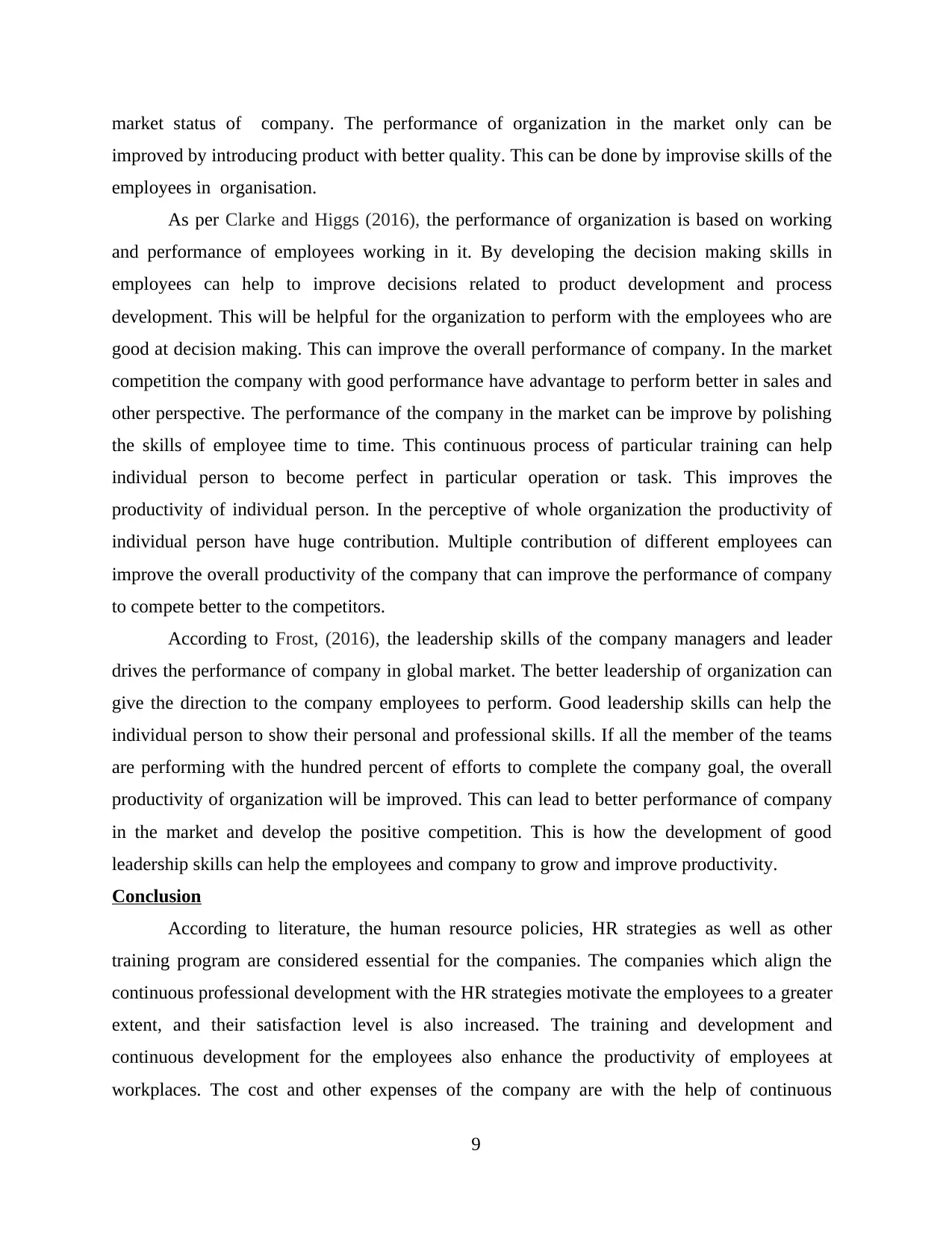
market status of company. The performance of organization in the market only can be
improved by introducing product with better quality. This can be done by improvise skills of the
employees in organisation.
As per Clarke and Higgs (2016), the performance of organization is based on working
and performance of employees working in it. By developing the decision making skills in
employees can help to improve decisions related to product development and process
development. This will be helpful for the organization to perform with the employees who are
good at decision making. This can improve the overall performance of company. In the market
competition the company with good performance have advantage to perform better in sales and
other perspective. The performance of the company in the market can be improve by polishing
the skills of employee time to time. This continuous process of particular training can help
individual person to become perfect in particular operation or task. This improves the
productivity of individual person. In the perceptive of whole organization the productivity of
individual person have huge contribution. Multiple contribution of different employees can
improve the overall productivity of the company that can improve the performance of company
to compete better to the competitors.
According to Frost, (2016), the leadership skills of the company managers and leader
drives the performance of company in global market. The better leadership of organization can
give the direction to the company employees to perform. Good leadership skills can help the
individual person to show their personal and professional skills. If all the member of the teams
are performing with the hundred percent of efforts to complete the company goal, the overall
productivity of organization will be improved. This can lead to better performance of company
in the market and develop the positive competition. This is how the development of good
leadership skills can help the employees and company to grow and improve productivity.
Conclusion
According to literature, the human resource policies, HR strategies as well as other
training program are considered essential for the companies. The companies which align the
continuous professional development with the HR strategies motivate the employees to a greater
extent, and their satisfaction level is also increased. The training and development and
continuous development for the employees also enhance the productivity of employees at
workplaces. The cost and other expenses of the company are with the help of continuous
9
improved by introducing product with better quality. This can be done by improvise skills of the
employees in organisation.
As per Clarke and Higgs (2016), the performance of organization is based on working
and performance of employees working in it. By developing the decision making skills in
employees can help to improve decisions related to product development and process
development. This will be helpful for the organization to perform with the employees who are
good at decision making. This can improve the overall performance of company. In the market
competition the company with good performance have advantage to perform better in sales and
other perspective. The performance of the company in the market can be improve by polishing
the skills of employee time to time. This continuous process of particular training can help
individual person to become perfect in particular operation or task. This improves the
productivity of individual person. In the perceptive of whole organization the productivity of
individual person have huge contribution. Multiple contribution of different employees can
improve the overall productivity of the company that can improve the performance of company
to compete better to the competitors.
According to Frost, (2016), the leadership skills of the company managers and leader
drives the performance of company in global market. The better leadership of organization can
give the direction to the company employees to perform. Good leadership skills can help the
individual person to show their personal and professional skills. If all the member of the teams
are performing with the hundred percent of efforts to complete the company goal, the overall
productivity of organization will be improved. This can lead to better performance of company
in the market and develop the positive competition. This is how the development of good
leadership skills can help the employees and company to grow and improve productivity.
Conclusion
According to literature, the human resource policies, HR strategies as well as other
training program are considered essential for the companies. The companies which align the
continuous professional development with the HR strategies motivate the employees to a greater
extent, and their satisfaction level is also increased. The training and development and
continuous development for the employees also enhance the productivity of employees at
workplaces. The cost and other expenses of the company are with the help of continuous
9
⊘ This is a preview!⊘
Do you want full access?
Subscribe today to unlock all pages.

Trusted by 1+ million students worldwide
1 out of 47
Related Documents
Your All-in-One AI-Powered Toolkit for Academic Success.
+13062052269
info@desklib.com
Available 24*7 on WhatsApp / Email
![[object Object]](/_next/static/media/star-bottom.7253800d.svg)
Unlock your academic potential
Copyright © 2020–2025 A2Z Services. All Rights Reserved. Developed and managed by ZUCOL.




